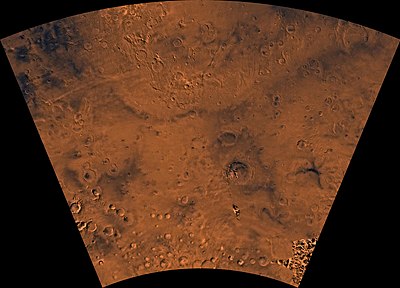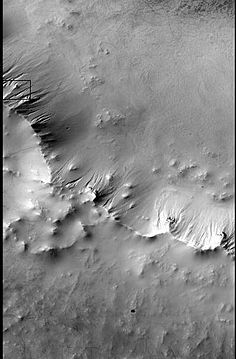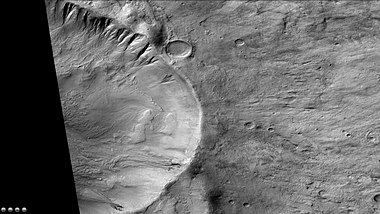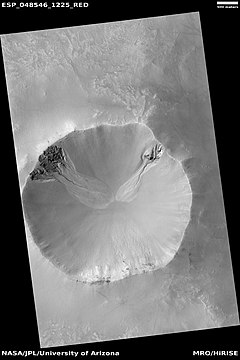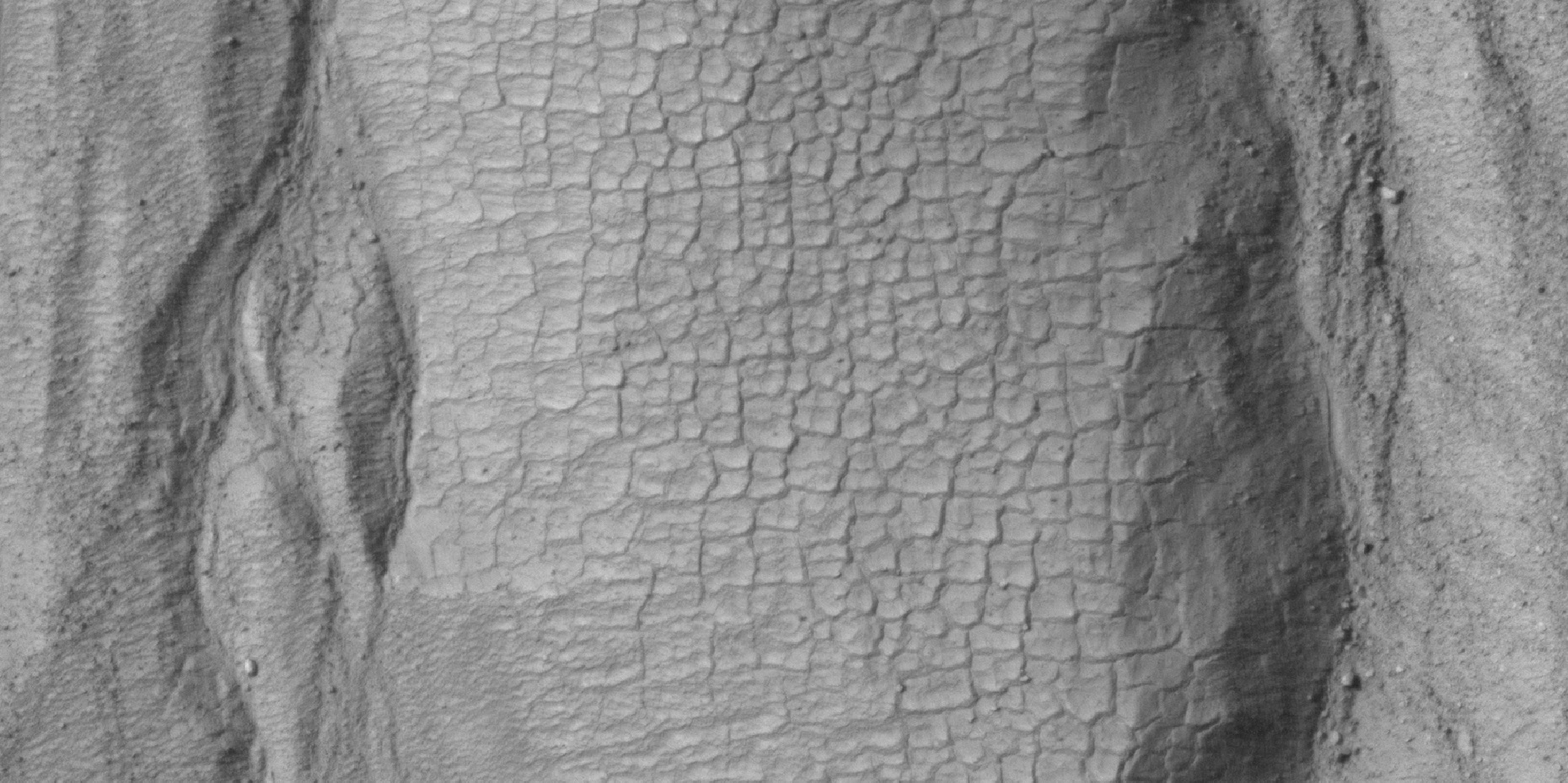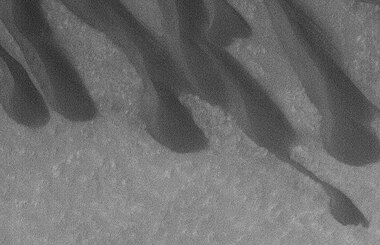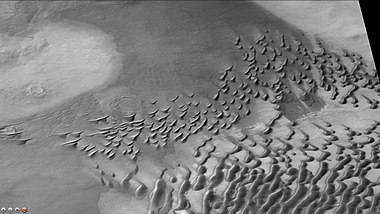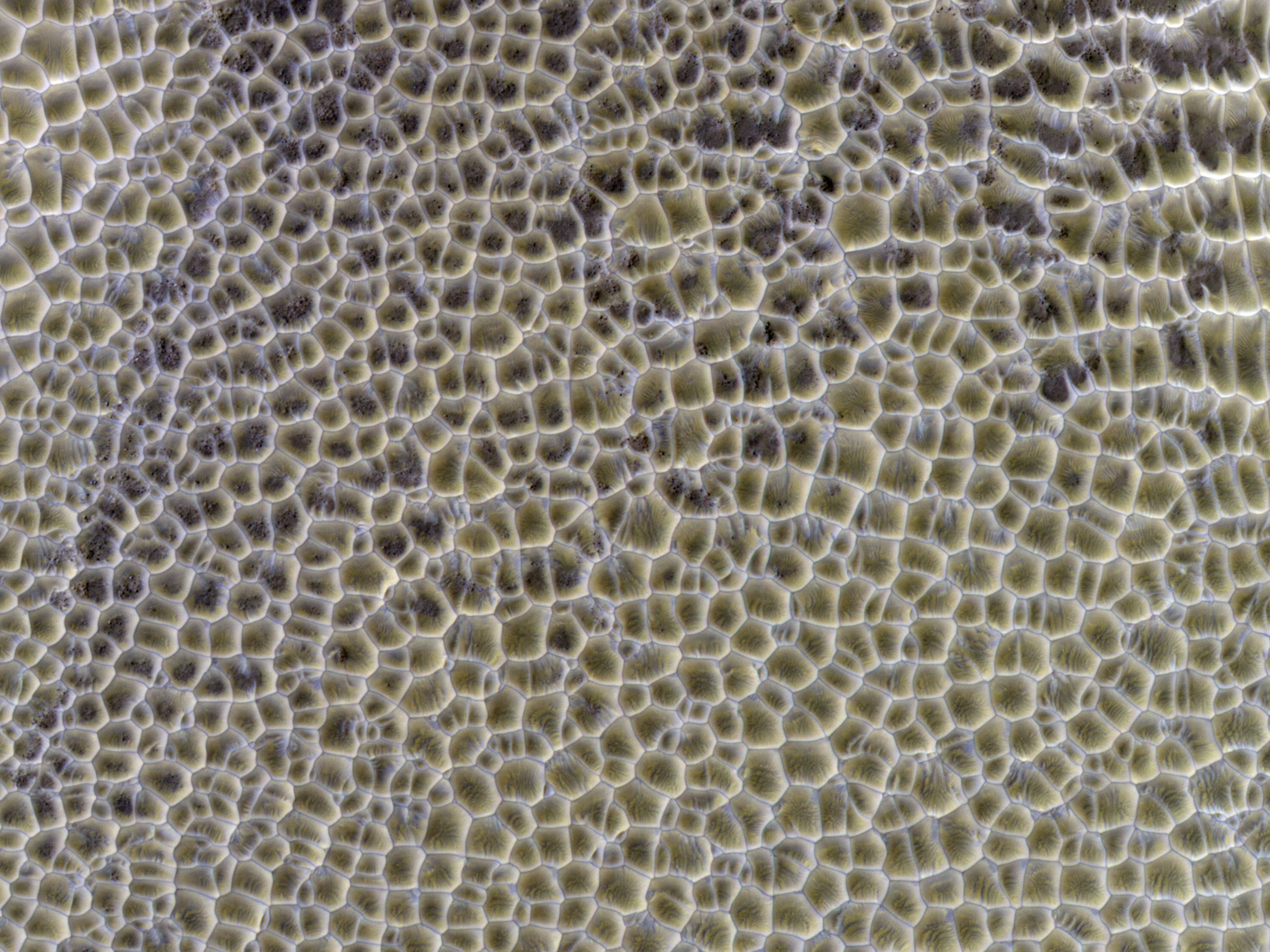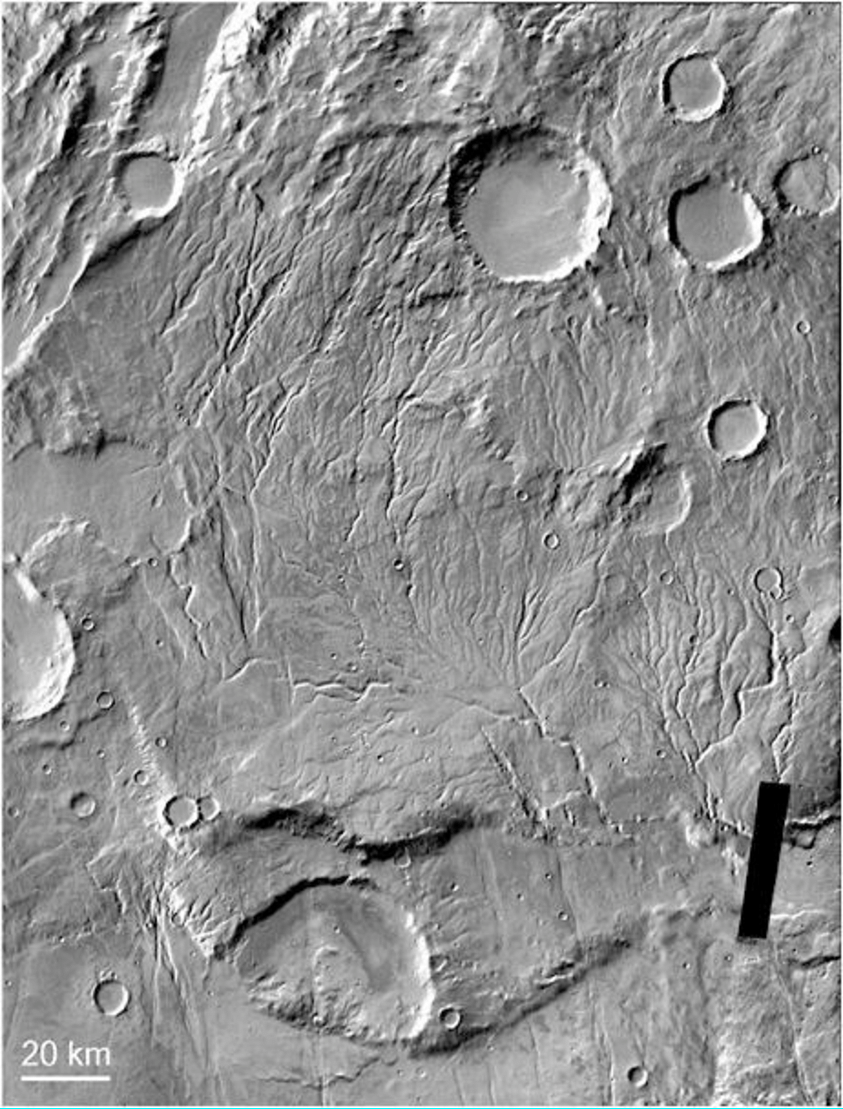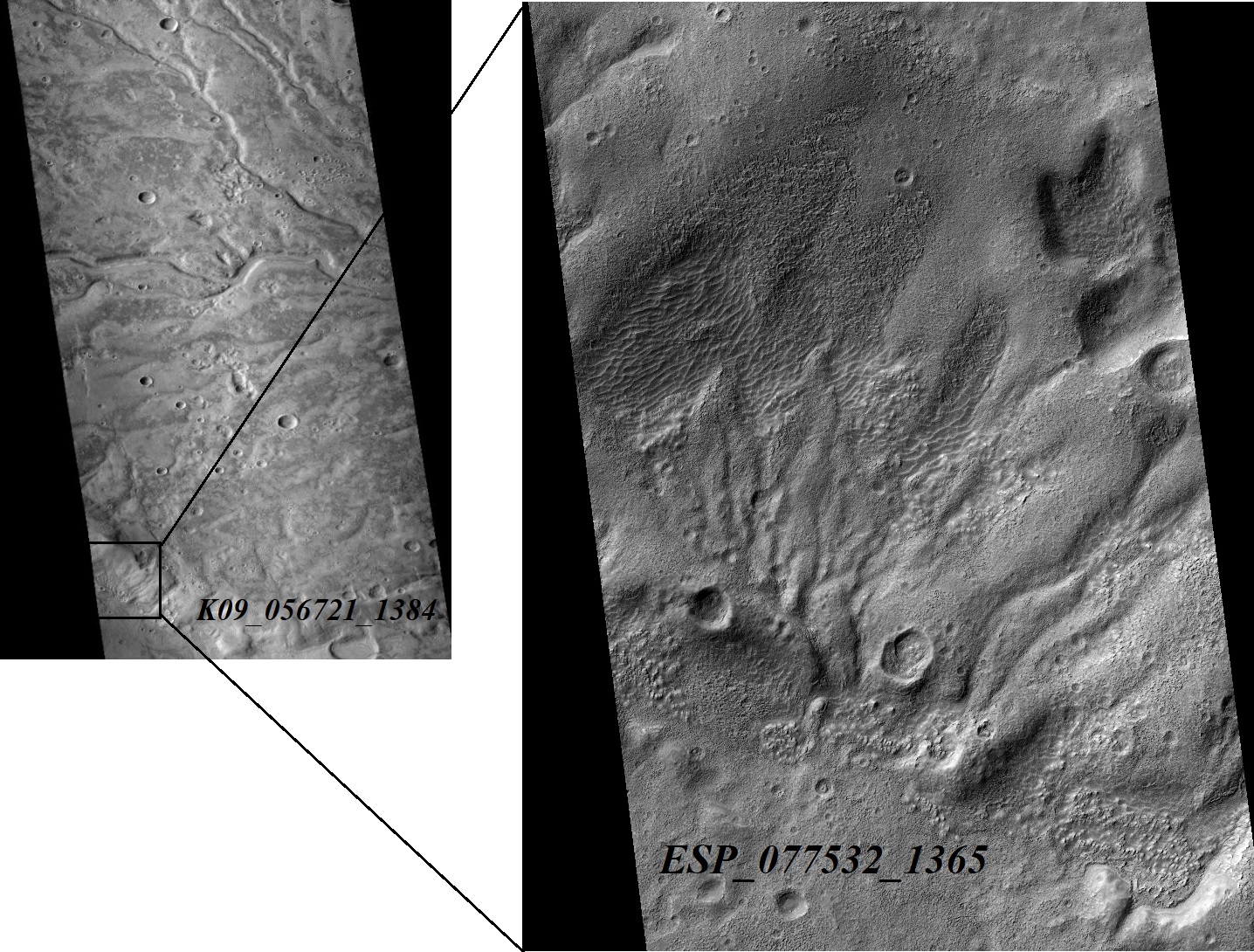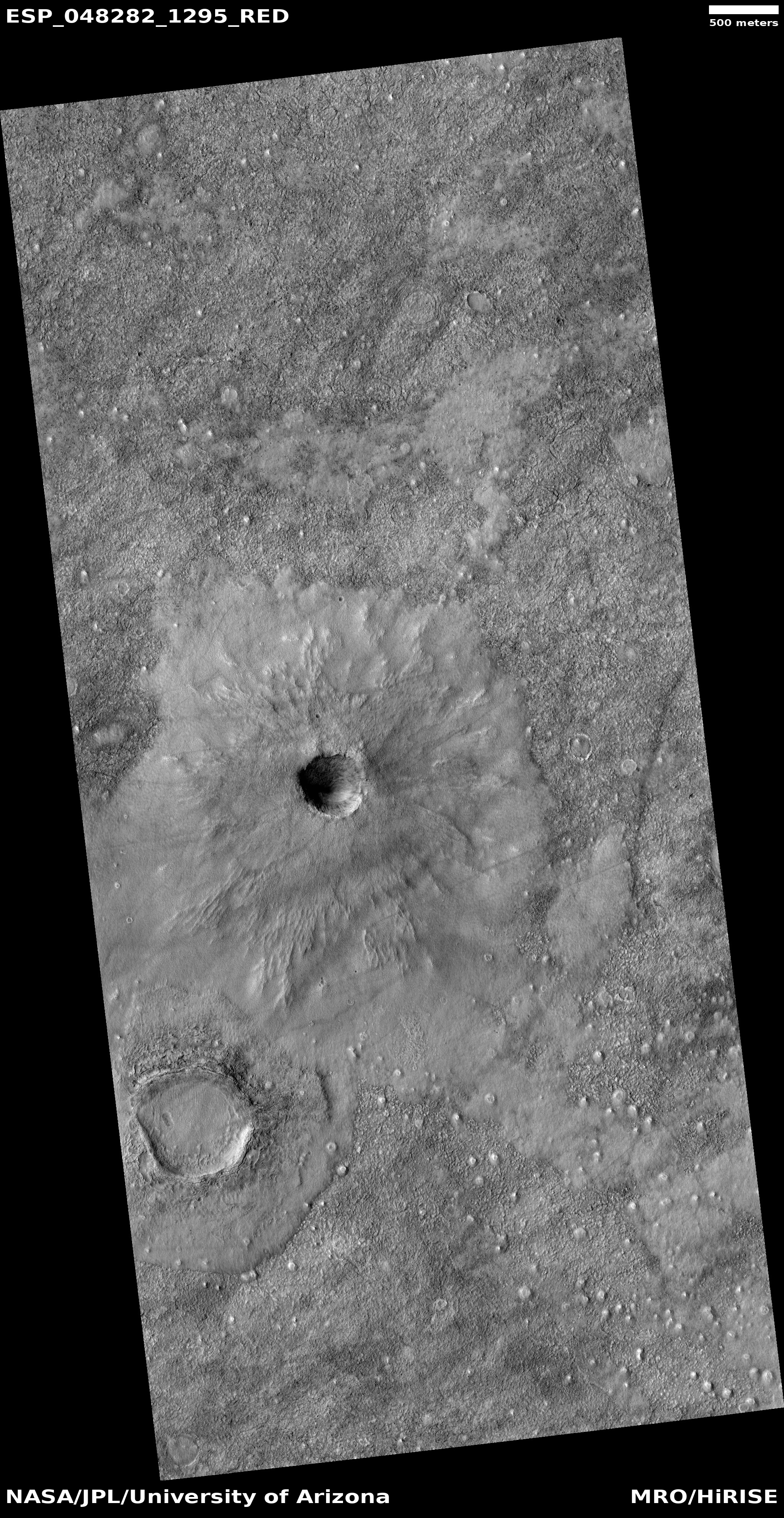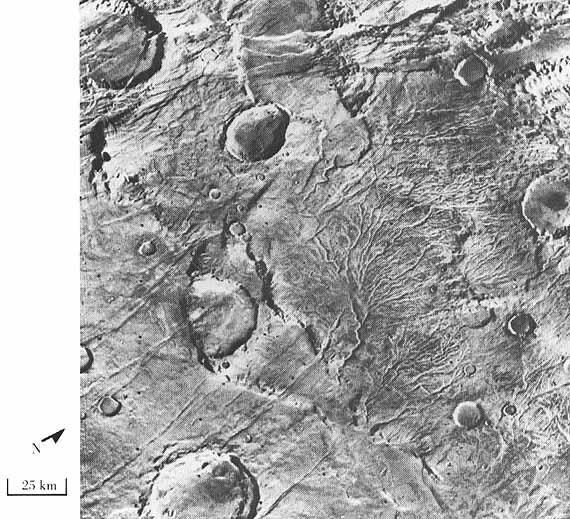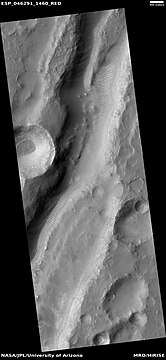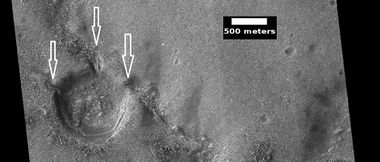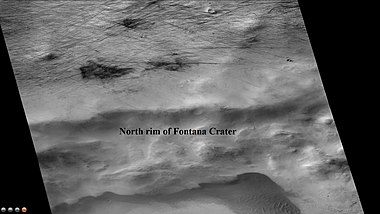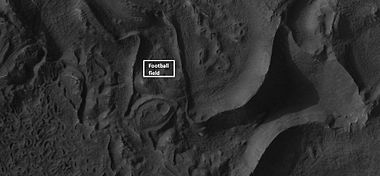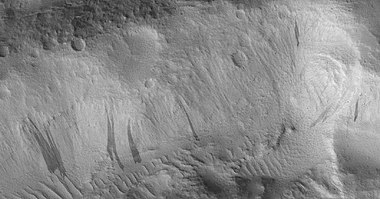Difference between revisions of "Thaumasia quadrangle"
Suitupshowup (talk | contribs) m (→Craters) |
|||
| (54 intermediate revisions by 2 users not shown) | |||
| Line 14: | Line 14: | ||
</gallery> | </gallery> | ||
| − | The Thaumasia quadrangle, is famous for showing us a good example of possible rainfall and rivers | + | The Thaumasia quadrangle, is famous for showing us a good example of possible past rainfall and rivers in pictures of Warrego Valles taken with [[Mariner 9]] and the Viking Orbiters. Those early images revealed a network of branching valleys. They were clear evidence that Mars may have once been warmer, wetter, and perhaps had precipitation in the form of rain or snow. Before we saw those pictures, we believed Mars was just an old, dry desert. |
| + | |||
The Thaumasia quadrangle is one of a series of 30 quadrangle maps of Mars used by the United States Geological Survey (USGS). The Thaumasia quadrangle is also referred to as MC-25 (Mars Chart-25).<ref>Davies, M.E.; Batson, R.M.; Wu, S.S.C. "Geodesy and Cartography" in Kieffer, H.H.; Jakosky, B.M.; Snyder, C.W.; Matthews, M.S., Eds. ''Mars.'' University of Arizona Press: Tucson, 1992.</ref> | The Thaumasia quadrangle is one of a series of 30 quadrangle maps of Mars used by the United States Geological Survey (USGS). The Thaumasia quadrangle is also referred to as MC-25 (Mars Chart-25).<ref>Davies, M.E.; Batson, R.M.; Wu, S.S.C. "Geodesy and Cartography" in Kieffer, H.H.; Jakosky, B.M.; Snyder, C.W.; Matthews, M.S., Eds. ''Mars.'' University of Arizona Press: Tucson, 1992.</ref> | ||
The Thaumasia quadrangle covers the area from 30° to 65° south latitude and 60° to 120° west longitude (300-240 E). It encompasses many different regions or parts of many regions that have classical names. The northern part includes Thaumasia plateau. The southern part contains heavily cratered highland terrain and relatively smooth, low plains, such as Aonia Planum and Icaria Planum. Parts of Solis Planum, Aonia Terra, and Bosporus Planum are also found in this quadrangle. The east-central part includes Lowell Crater. Lowell Crater was named after Percival Lowell who studied Mars with a telescope in Flagstaff Arizona and then went around the world promoting the idea that Mars was inhabited<ref>http://areology.blogspot.com/2010/06/ancient-lava-plain-in-thaumasia-planum.html</ref> | The Thaumasia quadrangle covers the area from 30° to 65° south latitude and 60° to 120° west longitude (300-240 E). It encompasses many different regions or parts of many regions that have classical names. The northern part includes Thaumasia plateau. The southern part contains heavily cratered highland terrain and relatively smooth, low plains, such as Aonia Planum and Icaria Planum. Parts of Solis Planum, Aonia Terra, and Bosporus Planum are also found in this quadrangle. The east-central part includes Lowell Crater. Lowell Crater was named after Percival Lowell who studied Mars with a telescope in Flagstaff Arizona and then went around the world promoting the idea that Mars was inhabited<ref>http://areology.blogspot.com/2010/06/ancient-lava-plain-in-thaumasia-planum.html</ref> | ||
The name comes from Thaumas, the god of the clouds and celestial apparitions.<ref>Blunck, J. 1982. Mars and its Satellites. Exposition Press. Smithtown, N.Y.</ref> | The name comes from Thaumas, the god of the clouds and celestial apparitions.<ref>Blunck, J. 1982. Mars and its Satellites. Exposition Press. Smithtown, N.Y.</ref> | ||
| + | |||
| + | In this article, some of the best pictures from a number of spacecraft will show what the landscape looks like in this region. The origins and significance of all features will be explained as they are currently understood. | ||
| + | |||
==[[Martian gullies]]== | ==[[Martian gullies]]== | ||
| + | |||
| + | [[File: Gulliesthaumasal.jpg|600pxr|Group of gullies, as seen by HiRISE under the HiWish program]] | ||
| + | Group of gullies, as seen by HiRISE under the HiWish program | ||
| + | |||
| + | |||
| + | |||
Gullies occur on steep slopes, especially on the walls of craters. Gullies are believed to be relatively young because they have few, if any craters. Moreover, they lie on top of sand dunes which themselves are considered to be quite young. Usually, each gully has an alcove, channel, and apron.<ref>Edgett |first1= K. |last2= Malin |first2= M. C. |last3= Williams |first3= R. M. E. |last4= Davis |first4= S. D. |date= 2003 |title= Polar-and middle-latitude martian gullies: A view from MGS MOC after 2 Mars years in the mapping orbit |journal= Lunar Planet. Sci. |volume=34 |at=p. 1038, Abstract 1038 | url=http://www.lpi.usra.edu/meetings/lpsc2003/pdf/1038.pdf |</ref> | Gullies occur on steep slopes, especially on the walls of craters. Gullies are believed to be relatively young because they have few, if any craters. Moreover, they lie on top of sand dunes which themselves are considered to be quite young. Usually, each gully has an alcove, channel, and apron.<ref>Edgett |first1= K. |last2= Malin |first2= M. C. |last3= Williams |first3= R. M. E. |last4= Davis |first4= S. D. |date= 2003 |title= Polar-and middle-latitude martian gullies: A view from MGS MOC after 2 Mars years in the mapping orbit |journal= Lunar Planet. Sci. |volume=34 |at=p. 1038, Abstract 1038 | url=http://www.lpi.usra.edu/meetings/lpsc2003/pdf/1038.pdf |</ref> | ||
| − | Gullies | + | Gullies were once thought to be caused by recent flowing water. However, with further extensive observations with HiRISE, it was found that many are forming/changing today, even though liquid water cannot exist under current Martian conditions. Faced with these new observations, scientists came up with other ideas to explain them. The consensus seems to be that although water may have helped form them in the past, today they are being produced by chunks of dry ice moving down steep slopes. <ref>Harrington |first=J.D. |last2=Webster |first2=Guy |title=RELEASE 14-191 – NASA Spacecraft Observes Further Evidence of Dry Ice Gullies on Mars |url=http://www.nasa.gov/press/2014/july/nasa-spacecraft-observes-further-evidence-of-dry-ice-gullies-on-mars |date=July 10, 2014 |work=NASA</ref> <ref>CNRS. "Gullies on Mars sculpted by dry ice rather than liquid water." ScienceDaily. ScienceDaily, 22 December 2015. www.sciencedaily.com/releases/2015/12/151222082255.htm </ref> <ref>http://www.skyandtelescope.com/astronomy-news/martian-gullies-triggered-by-exploding-dry-ice-122320158</ref> |
| − | There is evidence here in this quadrangle that indeed water may have aided in the formation of gullies. Measurements of altitudes and slopes of gullies support the idea that snowpacks or glaciers are associated with gullies. Steeper slopes have more shade which would preserve snow. | + | There is evidence here in this quadrangle that indeed water in the past may have aided in the formation of gullies. Measurements of altitudes and slopes of gullies support the idea that snowpacks or glaciers are associated with gullies. Steeper slopes have more shade which would preserve snow.<ref>Dickson, J. et al. 2007. Martian gullies in the southern mid-latitudes of Mars Evidence for climate-controlled formation of young fluvial features based upon local and global topography. Icarus: 188. 315-323.</ref> |
Higher elevations have far fewer gullies because ice would tend to sublimate more in the thin air of the higher altitude.<ref>Hecht, M. 2002. Metastability of liquid water on Mars. Icarus: 156. 373-386.</ref> This relationship seems to hold true in Thaumasia. This region is fairly high in evlevation and has very few gullies; however, a few are present in the lower elevations like the one pictured below in Ross Crater. | Higher elevations have far fewer gullies because ice would tend to sublimate more in the thin air of the higher altitude.<ref>Hecht, M. 2002. Metastability of liquid water on Mars. Icarus: 156. 373-386.</ref> This relationship seems to hold true in Thaumasia. This region is fairly high in evlevation and has very few gullies; however, a few are present in the lower elevations like the one pictured below in Ross Crater. | ||
| Line 27: | Line 37: | ||
Image:Context for Gullies in Ross crater.jpg|CTX image of part of Ross Crater showing context for next image from HiRISE. | Image:Context for Gullies in Ross crater.jpg|CTX image of part of Ross Crater showing context for next image from HiRISE. | ||
| − | Image:Gullies in Ross Crater.JPG|Gullies in Ross Crater | + | Image:Gullies in Ross Crater.JPG|Gullies in Ross Crater |
ESP 040186 1215multiplechannels.jpg|Close-up of gullies showing multiple channels | ESP 040186 1215multiplechannels.jpg|Close-up of gullies showing multiple channels | ||
| + | |||
ESP 040186 1215streamlined.jpg|Close-up of gullies showing streamlined forms in channels | ESP 040186 1215streamlined.jpg|Close-up of gullies showing streamlined forms in channels | ||
| + | |||
ESP 047333 1215gullies.jpg|Wide view of gullies in Ross Crater | ESP 047333 1215gullies.jpg|Wide view of gullies in Ross Crater | ||
Wikisliphergullies.jpg|Gullies in crater on the rim of Slipher Crater, as seen by CTX camera (on Mars Reconnaissance Orbiter) | Wikisliphergullies.jpg|Gullies in crater on the rim of Slipher Crater, as seen by CTX camera (on Mars Reconnaissance Orbiter) | ||
| − | |||
| − | |||
| − | |||
ESP 048546 1225gullies.jpg|Gullies | ESP 048546 1225gullies.jpg|Gullies | ||
</gallery> | </gallery> | ||
| + | |||
| + | [[File: 47333 1215polygonsclose2.jpg|600pxr|Close view of polygons that are near gullies in Ross Crater]] | ||
| + | Close view of polygons that are near gullies in Ross Crater | ||
==Sand Dunes== | ==Sand Dunes== | ||
| − | Many places on Mars have sand dunes. Some craters in Thaumasia show dark blotches in them. High resolution photos | + | |
| + | Many places on Mars have sand dunes. Some craters in Thaumasia show dark blotches in them. High resolution photos expose the dark markings as dark sand dunes. Dark sand dunes probably contain the igneous rock basalt.<ref>Michael H. Carr|title=The surface of Mars|url=https://books.google.com/books?id=uLHlJ6sjohwC|accessdate=21 March 2011|year=2006|publisher=Cambridge University Press|isbn=978-0-521-87201-0</ref> | ||
<gallery class="center" widths="380px" heights="360px"> | <gallery class="center" widths="380px" heights="360px"> | ||
| − | |||
Image:Context for Dunes in Brashear.jpg|[[Mars Global Surveyor]] context image with box showing where next image is located. | Image:Context for Dunes in Brashear.jpg|[[Mars Global Surveyor]] context image with box showing where next image is located. | ||
Image:Dunesinbrashear.jpg|Mars Global Surveyor image of part of area in the previous photo. The dark spots are resolved to be sand dunes. Image was taken under the MOC Public Targeting Program. | Image:Dunesinbrashear.jpg|Mars Global Surveyor image of part of area in the previous photo. The dark spots are resolved to be sand dunes. Image was taken under the MOC Public Targeting Program. | ||
| − | + | ||
Wikilamont.jpg|Lamont Crater, as seen by CTX camera (on Mars Reconnaissance Orbiter). Dark areas are composed of mostly dunes. | Wikilamont.jpg|Lamont Crater, as seen by CTX camera (on Mars Reconnaissance Orbiter). Dark areas are composed of mostly dunes. | ||
| + | |||
Wikilamontdunes.jpg|Dunes on floor of Lamont Crater, as seen by CTX camera (on Mars Reconnaissance Orbiter). Note: this is an enlargement of the previous image. | Wikilamontdunes.jpg|Dunes on floor of Lamont Crater, as seen by CTX camera (on Mars Reconnaissance Orbiter). Note: this is an enlargement of the previous image. | ||
</gallery> | </gallery> | ||
| + | [[File: ESP_028580_1385cells.jpg|600pxr|Crater floor covered with sand dunes in the shape of cells, as seen by HiRISE under HiWish program]] | ||
| + | Crater floor covered with sand dunes in the shape of cells, as seen by HiRISE under HiWish program | ||
| + | |||
| + | [[File:ESP 031138 1380dunes.jpg|600pxr|Dunes This image was named picture of the day for July 25, 2021]] | ||
| + | |||
| + | Dunes This image was named picture of the day for July 25, 2021 | ||
==Warrego Valles== | ==Warrego Valles== | ||
| − | |||
| − | < | + | [[Mariner 9]] and Viking Orbiter images, showed a network of branching valleys in Thaumasia called Warrego Valles. These networks are evidence that Mars may have once been warmer, wetter, and perhaps had precipitation in the form of rain or snow. A study with the Mars Orbiter Laser Altimeter, Thermal Emission Imaging System (THEMIS) and the Mars Orbiter Camera (MOC) support the idea that Warrego Valles was formed from precipitation.<ref>Ansan, V and N. Mangold. 2006. New observations of Warrego Valles, Mars: Evidence for precipitation and surface runoff. Icarus. 54:219-242.</ref> At first glance they resemble river valleys on our Earth. But sharper images from more advanced cameras reveal that the valleys are not continuous. They are very old and may have suffered from the effects of erosion. Pictures below show some of these branching valleys.<ref>http://www.msss.com/mars_images/moc/2004/10/03/</ref> |
| − | + | ||
| − | + | ||
| + | [[File:Warrego-Valles-system-located-at-422S-930W-The-drainage-density-of-this-Noachian.png|600pxr|Warrego Valles system as seen by the Thermal Emission Imaging System on the Mars Odyssey spacecraft]] | ||
| + | |||
| + | Warrego Valles system as seen by the Thermal Emission Imaging System on the Mars Odyssey spacecraft | ||
| + | |||
| + | |||
| + | [[File:77532 1365contextchannels.jpg|600pxr|Some channals of Warrego Valles, as seen by CTX and HiRISE]] | ||
| + | |||
| + | Close views of channels of Warrego Valles, as seen by CTX and HiRISE | ||
==Craters== | ==Craters== | ||
| + | |||
| + | [[File: ESP 048282 1295flamecrater.jpg|600pxr|Unnamed crater with thin ejecta There are also many cones visible in the image.]] | ||
| + | Unnamed crater with thin ejecta, as seen by HiRISE There are also many cones visible in the image. | ||
| + | |||
Thaumasia is in the old southern highlands of Mars. As such it is loaded with craters. Craters are important to scientists. | Thaumasia is in the old southern highlands of Mars. As such it is loaded with craters. Craters are important to scientists. | ||
The density of impact craters is used to determine the surface ages of Mars and other solar system bodies.<ref>http://www.lpi.usra.edu/publications/slidesets/stones/</ref> The older the surface, the more craters present. Crater shapes can reveal the presence of ground ice. | The density of impact craters is used to determine the surface ages of Mars and other solar system bodies.<ref>http://www.lpi.usra.edu/publications/slidesets/stones/</ref> The older the surface, the more craters present. Crater shapes can reveal the presence of ground ice. | ||
The area around craters may be rich in minerals. On Mars, heat from the impact melts ice in the ground. Water from the melting ice dissolves minerals, and then deposits them in cracks or faults that were produced with the impact. This process, called hydrothermal alteration, is a major way in which ore deposits are produced. The area around Martian craters may be rich in useful ores for the future colonization of Mars.<ref>http://www.indiana.edu/~sierra/papers/2003/Patterson.html.</ref> | The area around craters may be rich in minerals. On Mars, heat from the impact melts ice in the ground. Water from the melting ice dissolves minerals, and then deposits them in cracks or faults that were produced with the impact. This process, called hydrothermal alteration, is a major way in which ore deposits are produced. The area around Martian craters may be rich in useful ores for the future colonization of Mars.<ref>http://www.indiana.edu/~sierra/papers/2003/Patterson.html.</ref> | ||
| − | Studies on the | + | Studies on the Earth have documented that cracks are produced and that secondary minerals veins are deposited in the cracks.<ref>Osinski, G, J. Spray, and P. Lee. 2001. Impact-induced hydrothermal activity within the Haughton impact structure, arctic Canada: Generation of a transient, warm, wet oasis. Meteoritics & Planetary Science: 36. 731-745</ref> <ref>http://www.ingentaconnect.com/content/arizona/maps/2005/00000040/00000012/art00007</ref> <ref>Pirajno, F. 2000. Ore Deposits and Mantle Plumes. Kluwer Academic Publishers. Dordrecht, The Netherlands</ref> Images from satellites orbiting Mars have detected cracks near impact craters.<ref>Head, J. and J. Mustard. 2006. Breccia Dikes and Crater-Related Faults in Impact Craters on Mars: Erosion and Exposure on the Floor of a 75-km Diameter Crater at the Dichotomy Boundary. Special Issue on Role of Volatiles and Atmospheres on Martian Impact Craters Meteoritics & Planetary Science</ref> Great amounts of heat are produced during impacts. The area around a large impact may take hundreds of thousands of years to cool.<ref>name="news.discovery.com"</ref> <ref>Segura, T, O. Toon, A. Colaprete, K. Zahnle. 2001. Effects of Large Impacts on Mars: Implications for River Formation. American Astronomical Society, DPS meeting#33, #19.08</ref><ref>Segura, T, O. Toon, A. Colaprete, K. Zahnle. 2002. Environmental Effects of Large Impacts on Mars. Science: 298, 1977-1980.</ref> |
Many craters once contained lakes.<ref>Cabrol, N. and E. Grin. 2001. The Evolution of Lacustrine Environments on Mars: Is Mars Only Hydrologically Dormant? Icarus: 149, 291-328.</ref> <ref>Fassett, C. and J. Head. 2008. Open-basin lakes on Mars: Distribution and implications for Noachian surface and subsurface hydrology. Icarus: 198, 37-56.</ref> <ref>Fassett, C. and J. Head. 2008. Open-basin lakes on Mars: Implications of valley network lakes for the nature of Noachian hydrology.</ref> Because some crater floors show deltas, we know that water had to be present for some time. Dozens of deltas have been spotted on Mars.<ref>Wilson, J. A. Grant and A. Howard. 2013. INVENTORY OF EQUATORIAL ALLUVIAL FANS AND DELTAS ON MARS. 44th Lunar and Planetary Science Conference.</ref> Deltas form when sediment is washed in from a stream entering a quiet body of water. It takes a bit of time to form a delta, so the presence of a delta is exciting; it means water was there for a time, maybe for many years. Primitive organisms may have developed in such lakes; hence, some craters may be prime targets for the search for evidence of life on the Red Planet.<ref>Newsom H., Hagerty J., Thorsos I. 2001. Location and sampling of aqueous and hydrothermal deposits in martian impact craters. Astrobiology: 1, 71-88.</ref> | Many craters once contained lakes.<ref>Cabrol, N. and E. Grin. 2001. The Evolution of Lacustrine Environments on Mars: Is Mars Only Hydrologically Dormant? Icarus: 149, 291-328.</ref> <ref>Fassett, C. and J. Head. 2008. Open-basin lakes on Mars: Distribution and implications for Noachian surface and subsurface hydrology. Icarus: 198, 37-56.</ref> <ref>Fassett, C. and J. Head. 2008. Open-basin lakes on Mars: Implications of valley network lakes for the nature of Noachian hydrology.</ref> Because some crater floors show deltas, we know that water had to be present for some time. Dozens of deltas have been spotted on Mars.<ref>Wilson, J. A. Grant and A. Howard. 2013. INVENTORY OF EQUATORIAL ALLUVIAL FANS AND DELTAS ON MARS. 44th Lunar and Planetary Science Conference.</ref> Deltas form when sediment is washed in from a stream entering a quiet body of water. It takes a bit of time to form a delta, so the presence of a delta is exciting; it means water was there for a time, maybe for many years. Primitive organisms may have developed in such lakes; hence, some craters may be prime targets for the search for evidence of life on the Red Planet.<ref>Newsom H., Hagerty J., Thorsos I. 2001. Location and sampling of aqueous and hydrothermal deposits in martian impact craters. Astrobiology: 1, 71-88.</ref> | ||
<gallery class="center" widths="380px" heights="360px"> | <gallery class="center" widths="380px" heights="360px"> | ||
| − | |||
| − | |||
Wikilampland.jpg|Lampland Crater, as seen by CTX camera (on Mars Reconnaissance Orbiter). | Wikilampland.jpg|Lampland Crater, as seen by CTX camera (on Mars Reconnaissance Orbiter). | ||
| + | |||
Wikilamplandlayers.jpg|Layers in wall of Lampland Crater, as seen by CTX camera (on Mars Reconnaissance Orbiter). Note: this is an enlargement of the previous image of Lampland Crater. | Wikilamplandlayers.jpg|Layers in wall of Lampland Crater, as seen by CTX camera (on Mars Reconnaissance Orbiter). Note: this is an enlargement of the previous image of Lampland Crater. | ||
| + | |||
ESP 043350 1430pointedcrater.jpg|Pointed crater, as seen by HiRISE under HiWish program Impacting object may have struck at a low angle. | ESP 043350 1430pointedcrater.jpg|Pointed crater, as seen by HiRISE under HiWish program Impacting object may have struck at a low angle. | ||
</gallery> | </gallery> | ||
| Line 87: | Line 117: | ||
==Channels== | ==Channels== | ||
| + | |||
| + | [[File: Branched Channels from Viking.jpg|600pxr|Branched channels in Thaumasia quadrangle, as seen by Viking Orbiter. Networks of channels like this are strong evidence for rain on Mars in the past.]] | ||
| + | |||
| + | |||
| + | |||
| + | Branched channels in Thaumasia quadrangle, as seen by Viking Orbiter. Networks of channels like this are strong evidence for rain on Mars in the past. | ||
| + | |||
In the nearly half century of studying the Red Planet with orbiting satellites, much evidence has accumulating to prove that water once flowed in river valleys on Mars.<ref>Baker, V., et al. 2015. Fluvial geomorphology on Earth-like planetary surfaces: a review. Geomorphology. 245, 149–182.</ref> <ref>Carr, M. 1996. in Water on Mars. Oxford Univ. Press.</ref> Images of curved channels have been seen in images from Mars spacecraft dating back to the early seventies with the [[Mariner 9]] orbiter.<ref>Baker, V. 1982. The Channels of Mars. Univ. of Tex. Press, Austin, TX</ref> <ref>Baker, V., R. Strom, R., V. Gulick, J. Kargel, G. Komatsu, V. Kale. 1991. Ancient oceans, ice sheets and the hydrological cycle on Mars. Nature 352, 589–594.</ref> <ref>Carr, M. 1979. Formation of Martian flood features by release of water from confined aquifers. J. Geophys. Res. 84, 2995–300.</ref> <ref>Komar, P. 1979. Comparisons of the hydraulics of water flows in Martian outflow channels with flows of similar scale on Earth. Icarus 37, 156–181.</ref> Indeed, a study published in June 2017, calculated that the volume of water needed to carve all the channels on Mars was even larger than the proposed ocean that the planet may have had. Water was probably recycled many times from the ocean to rainfall around Mars.<ref>http://spaceref.com/mars/how-much-water-was-needed-to-carve-valleys-on-mars.html</ref><ref>Luo, W., et al. 2017. New Martian valley network volume estimate consistent with ancient ocean and warm and wet climate. Nature Communications 8. Article number: 15766 (2017). doi:10.1038/ncomms15766</ref> | In the nearly half century of studying the Red Planet with orbiting satellites, much evidence has accumulating to prove that water once flowed in river valleys on Mars.<ref>Baker, V., et al. 2015. Fluvial geomorphology on Earth-like planetary surfaces: a review. Geomorphology. 245, 149–182.</ref> <ref>Carr, M. 1996. in Water on Mars. Oxford Univ. Press.</ref> Images of curved channels have been seen in images from Mars spacecraft dating back to the early seventies with the [[Mariner 9]] orbiter.<ref>Baker, V. 1982. The Channels of Mars. Univ. of Tex. Press, Austin, TX</ref> <ref>Baker, V., R. Strom, R., V. Gulick, J. Kargel, G. Komatsu, V. Kale. 1991. Ancient oceans, ice sheets and the hydrological cycle on Mars. Nature 352, 589–594.</ref> <ref>Carr, M. 1979. Formation of Martian flood features by release of water from confined aquifers. J. Geophys. Res. 84, 2995–300.</ref> <ref>Komar, P. 1979. Comparisons of the hydraulics of water flows in Martian outflow channels with flows of similar scale on Earth. Icarus 37, 156–181.</ref> Indeed, a study published in June 2017, calculated that the volume of water needed to carve all the channels on Mars was even larger than the proposed ocean that the planet may have had. Water was probably recycled many times from the ocean to rainfall around Mars.<ref>http://spaceref.com/mars/how-much-water-was-needed-to-carve-valleys-on-mars.html</ref><ref>Luo, W., et al. 2017. New Martian valley network volume estimate consistent with ancient ocean and warm and wet climate. Nature Communications 8. Article number: 15766 (2017). doi:10.1038/ncomms15766</ref> | ||
<gallery class="center" widths="380px" heights="360px"> | <gallery class="center" widths="380px" heights="360px"> | ||
| − | |||
| − | |||
ESP 046291 1460channel.jpg|Channel, as seen by HiRISE under HiWish program | ESP 046291 1460channel.jpg|Channel, as seen by HiRISE under HiWish program | ||
File:ESP 054821 1455channel.jpg|Channel In this image you can see how the channel cut through a ridge. | File:ESP 054821 1455channel.jpg|Channel In this image you can see how the channel cut through a ridge. | ||
| − | File:ESP 054874 1425channel.jpg|Channel | + | File:ESP 054874 1425channel.jpg|Channel Location is 36.968 S and 78.121 W. |
| − | File:ESP 056800 1385channels.jpg|Crater with channels | + | File:ESP 056800 1385channels.jpg|Crater with channels Arrows show channels that carried water into and out of crater. |
</gallery> | </gallery> | ||
==Latitude dependent mantle== | ==Latitude dependent mantle== | ||
| + | |||
Much of the Martian surface is covered with a thick ice-rich, mantle layer that has fallen from the sky a number of times in the past.<ref>Hecht | first1 = M | year = 2002 | title = Metastability of water on Mars | url = | journal = Icarus | volume = 156 | issue = 2| pages = 373–386 | doi=10.1006/icar.2001.6794 |</ref> <ref>Mustard | first1 = J. |display-authors=etal | year = 2001 | title = Evidence for recent climate change on Mars from the identification of youthful near-surface ground ice | url = | journal = Nature | volume = 412 | issue = 6845| pages = 411–414 |</ref> <ref>Pollack | first1 = J. | last2 = Colburn | first2 = D. | last3 = Flaser | first3 = F. | last4 = Kahn | first4 = R. | last5 = Carson | first5 = C. | last6 = Pidek | first6 = D. | year = 1979 | title = Properties and effects of dust suspended in the martian atmosphere | url = | journal = J. Geophys. Res. | volume = 84 | issue = | pages = 2929–2945 | doi=10.1029/jb084ib06p02929 |</ref> | Much of the Martian surface is covered with a thick ice-rich, mantle layer that has fallen from the sky a number of times in the past.<ref>Hecht | first1 = M | year = 2002 | title = Metastability of water on Mars | url = | journal = Icarus | volume = 156 | issue = 2| pages = 373–386 | doi=10.1006/icar.2001.6794 |</ref> <ref>Mustard | first1 = J. |display-authors=etal | year = 2001 | title = Evidence for recent climate change on Mars from the identification of youthful near-surface ground ice | url = | journal = Nature | volume = 412 | issue = 6845| pages = 411–414 |</ref> <ref>Pollack | first1 = J. | last2 = Colburn | first2 = D. | last3 = Flaser | first3 = F. | last4 = Kahn | first4 = R. | last5 = Carson | first5 = C. | last6 = Pidek | first6 = D. | year = 1979 | title = Properties and effects of dust suspended in the martian atmosphere | url = | journal = J. Geophys. Res. | volume = 84 | issue = | pages = 2929–2945 | doi=10.1029/jb084ib06p02929 |</ref> | ||
| + | |||
<gallery class="center" widths="380px" heights="360px"> | <gallery class="center" widths="380px" heights="360px"> | ||
| + | |||
ESP 042123 1475mantle.jpg|Mantle layers exposed on crater rim, as seen by HiRISE under HiWish program Mantle is an ice-rich material that fell from the sky when the climate underwent major changes. | ESP 042123 1475mantle.jpg|Mantle layers exposed on crater rim, as seen by HiRISE under HiWish program Mantle is an ice-rich material that fell from the sky when the climate underwent major changes. | ||
| − | Image:Layered mantle in Icaria Planum.JPG|Layers in mantle deposit, as seen by HiRISE, under the [[HiWish program]]. | + | |
| − | Image:ESP_024863movement.jpg| | + | Image:Layered mantle in Icaria Planum.JPG|Layers in mantle deposit, as seen by HiRISE, under the [[HiWish program]]. Each layer probably fell from the sky each time the climate changed. |
| + | Image:ESP_024863movement.jpg|Mantle on inside of crater | ||
</gallery> | </gallery> | ||
==Dust devil tracks== | ==Dust devil tracks== | ||
| + | |||
Dust devil tracks are very common on Mars, especially in certain seasons. Dust devils can create very pretty tracks. Dust devils remove bright colored dust from the Martian surface; thereby exposing a dark layer. A thin coating of fine bright dust covers most of the Martian surface. When a dust devil goes by it blows away the coating and exposes the underlying dark surface creating tracks. It does not take too much fine dust to cover those tracks--experiments in Earth laboratories demonstrate that only a few 10's of microns of dust will be enough. The width of a single human hair ranges from approximately 20 to 200 microns (μm); consequently, the dust that can cover dust devil tracks may only be the thickness of a human hair.<ref>https://en.wikipedia.org/wiki/Micrometre</ref> Dust devils on Mars have been photographed both from the ground and high overhead from orbit. They have even blown dust off the solar panels of two Rovers on Mars, thereby greatly extending their useful lifetime.<ref>http://marsrovers.jpl.nasa.gov/gallery/press/spirit/20070412a.html Mars Exploration Rover Mission: Press Release Images: Spirit. Marsrovers.jpl.nasa.gov. Retrieved on 7 August 2011.</ref> The pattern of tracks has been shown to change every few months.<ref>http://hirise.lpl.arizona.edu/PSP_005383_1255</ref> A study that combined data from the High Resolution Stereo Camera (HRSC) and the Mars Orbiter Camera (MOC) found that some large dust devils on Mars have a diameter of 700 m and last at least 26 minutes.<ref>Reiss, D. et al. 2011. Multitemporal observations of identical active dust devils on Mars with High Resolution Stereo Camera (HRSC) and Mars Orbiter Camera (MOC). Icarus. 215:358-369.</ref> | Dust devil tracks are very common on Mars, especially in certain seasons. Dust devils can create very pretty tracks. Dust devils remove bright colored dust from the Martian surface; thereby exposing a dark layer. A thin coating of fine bright dust covers most of the Martian surface. When a dust devil goes by it blows away the coating and exposes the underlying dark surface creating tracks. It does not take too much fine dust to cover those tracks--experiments in Earth laboratories demonstrate that only a few 10's of microns of dust will be enough. The width of a single human hair ranges from approximately 20 to 200 microns (μm); consequently, the dust that can cover dust devil tracks may only be the thickness of a human hair.<ref>https://en.wikipedia.org/wiki/Micrometre</ref> Dust devils on Mars have been photographed both from the ground and high overhead from orbit. They have even blown dust off the solar panels of two Rovers on Mars, thereby greatly extending their useful lifetime.<ref>http://marsrovers.jpl.nasa.gov/gallery/press/spirit/20070412a.html Mars Exploration Rover Mission: Press Release Images: Spirit. Marsrovers.jpl.nasa.gov. Retrieved on 7 August 2011.</ref> The pattern of tracks has been shown to change every few months.<ref>http://hirise.lpl.arizona.edu/PSP_005383_1255</ref> A study that combined data from the High Resolution Stereo Camera (HRSC) and the Mars Orbiter Camera (MOC) found that some large dust devils on Mars have a diameter of 700 m and last at least 26 minutes.<ref>Reiss, D. et al. 2011. Multitemporal observations of identical active dust devils on Mars with High Resolution Stereo Camera (HRSC) and Mars Orbiter Camera (MOC). Icarus. 215:358-369.</ref> | ||
<gallery class="center" widths="380px" heights="360px"> | <gallery class="center" widths="380px" heights="360px"> | ||
| − | Wikifontanadevils.jpg|Dust devil tracks just outside north rim of Fontana Crater, as seen by CTX camera (on Mars Reconnaissance Orbiter) | + | Wikifontanadevils.jpg|Dust devil tracks just outside north rim of Fontana Crater, as seen by CTX camera (on Mars Reconnaissance Orbiter). |
| − | + | ||
</gallery> | </gallery> | ||
| + | |||
| + | [[File:Wikibiachini.jpg |600pxr|Biachini Crater, as seen by CTX camera (on Mars Reconnaissance Orbiter). Dust devil tracks and dunes are visible on the floor. The narrow, dark lines are dust devil tracks.]] | ||
| + | Biachini Crater, as seen by CTX camera (on Mars Reconnaissance Orbiter). Dust devil tracks and dunes are visible on the floor. The narrow, dark lines are dust devil tracks. | ||
| + | |||
| + | ==Glaciers== | ||
| + | |||
| + | Since the 70’s, as our spacecraft have studied Mars with more and more advanced cameras and other instruments, we have found more and more evidence for glaciers. <ref>Squyres | first1 = S.W. | last2 = Carr | first2 = M.H. | year = 1986 | title = Geomorphic evidence for the distribution of ground ice on Mars | url = | journal = Science | volume = 213 | issue = | pages = 249–253 | doi = 10.1126/science.231.4735.249 | </ref> <ref>Head | first1 = J.W. | last2 = Marchant | first2 = D.R. | last3 = Dickson | first3 = J.L. | last4 = Kress | first4 = A.M. | year = 2010 | title = Criteria for the recognition of debris-covered glacier and valley glacier landsystem deposits | url = | journal = Earth Planet. Sci. Lett. | volume = 294 | issue = | pages = 306–320 | doi=10.1016/j.epsl.2009.06.041 | </ref> <ref> Holt | first1 = J.W. | display-authors = 1 | last2 = et al | year = 2008 | title = Radar sounding evidence for buried glaciers in the southern mid-latitudes of Mars | url = | journal = Science | volume = 322 | issue = | pages = 1235–1238 | doi=10.1126/science.1164246 | pmid=19023078|</ref> <ref>Morgan | first1 = G.A. | last2 = Head | first2 = J.W. | last3 = Marchant | first3 = D.R. | year = 2009 | title = Lineated valley fill (LVF) and lobate debris aprons (LDA) in the Deuteronilus Mensae northern dichotomy boundary region, Mars: Constraints on the extent, age and episodicity of Amazonian glacial events | url = | journal = Icarus | volume = 202 | issue = | pages = 22–38 | doi=10.1016/j.icarus.2009.02.017 |</ref > <ref>Plaut | first1 = J.J. | last2 = Safaeinili | first2 = A. | last3 = Holt | first3 = J.W. | last4 = Phillips | first4 = R.J. | last5 = Head | first5 = J.W. | last6 = Sue | first6 = R. | last7 = Putzig | first7 = A. | year = 2009 | title = Frigeri Radar evidence for ice in lobate debris aprons in the mid-northern latitudes of Mars | doi = 10.1029/2008gl036379 | journal = Geophys. Res. Lett. | volume = 36 | issue = | page = L02203 | </ref> <ref>Baker | first1 = D.M.H. | last2 = Head | first2 = J.W. | last3 = Marchant | first3 = D.R. | year = 2010 | title = Flow patterns of lobate debris aprons and lineated valley fill north of Ismeniae Fossae, Mars: Evidence for extensive mid-latitude glaciation in the Late Amazonian | url = | journal = Icarus | volume = 207 | issue = | pages = 186–209 | doi=10.1016/j.icarus.2009.11.017 | </ref> <ref>Arfstrom | first1 = J. | year = 2005 | title = Terrestrial analogs and interrelationships | url = | journal = Icarus | volume = 174 | issue = | pages = 321–335 | doi=10.1016/j.icarus.2004.05.026 |</ref> On Mars these glaciers are covered with rock and dust debris a few meters to a few tens of meters thick. Although Mars today seems too dry for any glaciers, this covering material has protected the underlying ice. <ref>Williams | first1 = K. E. | display-authors = 1 | last2 = et al | year = 2008 | title = Stability of mid-latitude snowpacks on Mars | url = | journal = Icarus | volume = 196 | issue = 2| pages = 565–577 | doi=10.1016/j.icarus.2008.03.017 |</ref> One would think that under today’s conditions any exposed ice would undergo [[sublimation]] and disappear into the thin Martian atmosphere. That is, it would go directly from a solid to a gas. But, the isulating effect of surface material prevents loss of ice.<ref>Head | first1 = J. | date = 2005 | last2 = Neukum | first2 = G. | last3 = Jaumann | first3 = R. | last4 = Hiesinger | first4 = H. | last5 = Hauber | first5 = E. | last6 = Carr | first6 = M. | last7 = Masson | first7 = P. | last8 = Foing | first8 = B. | last9 = Hoffmann | first9 = H. | last10 = Kreslavsky | first10 = M. | last11 = Werner | first11 = S. | last12 = Milkovich | first12 = S. | last13 = Van Gasselt | first13 = S. | last14 = Co-Investigator Team | first14 = The Hrsc | title = Tropical to mid-latitude snow and ice accumulation, flow and glaciation on Mars | url = | journal=Nature | volume = 434 | issue = 7031| pages = 346–350 | pmid=15772652|</ref> <ref> Head, J., et al. 2009. Northern mid-latitude glaciation in the Late Amazonian period of Mars: Criteria for the recognition of debris-covered glacier and valley glacier landsystem deposits. Earth and Planetary Science Letters. Doi:10.1016/j.epsl.2009.06.041</ref> Sometimes, the glaciers are active for a time and then the ice in them leaves. However, they leave behind ridges of debris that was carried within and on top of the ice. Often, the ridges make a curved shape. | ||
| + | |||
| + | <gallery class="center" widths="380px" heights="360px"> | ||
| + | |||
| + | ESP 045526 1385flow.jpg|Curved ridge that probably was left by glacier, as seen by HiRISE under HiWish program | ||
| + | |||
| + | </gallery> | ||
| + | |||
| + | [[File:ESP 056642 1370flows.jpg|600pxr|Arrows indicate glaciers]] | ||
| + | Arrows indicate glaciers | ||
==Other views from Thaumasia== | ==Other views from Thaumasia== | ||
| + | |||
| + | [[File:45737 1380brains.jpg|600pxr| Brain terrain when ice leaves the ground along cracks. It may still contain some ice. Box shows the size of football field.]] | ||
| + | Brain terrain when ice leaves the ground along cracks. It may still contain some ice. Box shows the size of football field. | ||
<gallery class="center" widths="380px" heights="360px"> | <gallery class="center" widths="380px" heights="360px"> | ||
| − | Image:24400dike.jpg|Possible dike in Thaumasia | + | Image:24400dike.jpg|Possible dike in Thaumasia Dikes may have deposited valuable minerals. |
| − | Image:28384pitsandhollows.jpg|Strange surface features, as seen by HiWish under the HiWish program. | + | Image:28384pitsandhollows.jpg|Strange surface features, as seen by HiWish under the HiWish program. The box indicates the size of a football field. |
| − | + | File:ESP 054954 1425ridges.jpg|Ridges We are not quite sure what causes these types of ridges. | |
| − | File:ESP | ||
| − | + | File:56642 1370streaks.jpg|Dark slope streaks, as seen by HiRISE under[[HiWish program]] Dark slope streaks are when bright dust moves down a slope and exposes the underlying dark surface. | |
| − | + | </gallery> | |
| − | |||
| − | File: | + | [[File:46106 1390cracks.jpg|600pxr|Cracks and pits that form square shapes Arrow points to squares formed by cracks.]] |
| − | + | Cracks and pits that form square shapes Arrow points to squares formed by cracks. | |
==See also== | ==See also== | ||
| Line 150: | Line 207: | ||
==External links== | ==External links== | ||
| + | |||
| + | *[https://www.uahirise.org/PSP_005383_1255 Changes in dust devil tracks] | ||
Latest revision as of 17:00, 23 December 2023
| MC-25 | Thaumasia | 30–65° S | 60–120° W | Quadrangles | Atlas |
The Thaumasia quadrangle, is famous for showing us a good example of possible past rainfall and rivers in pictures of Warrego Valles taken with Mariner 9 and the Viking Orbiters. Those early images revealed a network of branching valleys. They were clear evidence that Mars may have once been warmer, wetter, and perhaps had precipitation in the form of rain or snow. Before we saw those pictures, we believed Mars was just an old, dry desert.
The Thaumasia quadrangle is one of a series of 30 quadrangle maps of Mars used by the United States Geological Survey (USGS). The Thaumasia quadrangle is also referred to as MC-25 (Mars Chart-25).[1] The Thaumasia quadrangle covers the area from 30° to 65° south latitude and 60° to 120° west longitude (300-240 E). It encompasses many different regions or parts of many regions that have classical names. The northern part includes Thaumasia plateau. The southern part contains heavily cratered highland terrain and relatively smooth, low plains, such as Aonia Planum and Icaria Planum. Parts of Solis Planum, Aonia Terra, and Bosporus Planum are also found in this quadrangle. The east-central part includes Lowell Crater. Lowell Crater was named after Percival Lowell who studied Mars with a telescope in Flagstaff Arizona and then went around the world promoting the idea that Mars was inhabited[2] The name comes from Thaumas, the god of the clouds and celestial apparitions.[3]
In this article, some of the best pictures from a number of spacecraft will show what the landscape looks like in this region. The origins and significance of all features will be explained as they are currently understood.
Contents
Martian gullies
Group of gullies, as seen by HiRISE under the HiWish program
Gullies occur on steep slopes, especially on the walls of craters. Gullies are believed to be relatively young because they have few, if any craters. Moreover, they lie on top of sand dunes which themselves are considered to be quite young. Usually, each gully has an alcove, channel, and apron.[4] Gullies were once thought to be caused by recent flowing water. However, with further extensive observations with HiRISE, it was found that many are forming/changing today, even though liquid water cannot exist under current Martian conditions. Faced with these new observations, scientists came up with other ideas to explain them. The consensus seems to be that although water may have helped form them in the past, today they are being produced by chunks of dry ice moving down steep slopes. [5] [6] [7] There is evidence here in this quadrangle that indeed water in the past may have aided in the formation of gullies. Measurements of altitudes and slopes of gullies support the idea that snowpacks or glaciers are associated with gullies. Steeper slopes have more shade which would preserve snow.[8] Higher elevations have far fewer gullies because ice would tend to sublimate more in the thin air of the higher altitude.[9] This relationship seems to hold true in Thaumasia. This region is fairly high in evlevation and has very few gullies; however, a few are present in the lower elevations like the one pictured below in Ross Crater.
Close view of polygons that are near gullies in Ross Crater
Sand Dunes
Many places on Mars have sand dunes. Some craters in Thaumasia show dark blotches in them. High resolution photos expose the dark markings as dark sand dunes. Dark sand dunes probably contain the igneous rock basalt.[10]
Mars Global Surveyor context image with box showing where next image is located.
Crater floor covered with sand dunes in the shape of cells, as seen by HiRISE under HiWish program
Dunes This image was named picture of the day for July 25, 2021
Warrego Valles
Mariner 9 and Viking Orbiter images, showed a network of branching valleys in Thaumasia called Warrego Valles. These networks are evidence that Mars may have once been warmer, wetter, and perhaps had precipitation in the form of rain or snow. A study with the Mars Orbiter Laser Altimeter, Thermal Emission Imaging System (THEMIS) and the Mars Orbiter Camera (MOC) support the idea that Warrego Valles was formed from precipitation.[11] At first glance they resemble river valleys on our Earth. But sharper images from more advanced cameras reveal that the valleys are not continuous. They are very old and may have suffered from the effects of erosion. Pictures below show some of these branching valleys.[12]
Warrego Valles system as seen by the Thermal Emission Imaging System on the Mars Odyssey spacecraft
Close views of channels of Warrego Valles, as seen by CTX and HiRISE
Craters
Unnamed crater with thin ejecta, as seen by HiRISE There are also many cones visible in the image.
Thaumasia is in the old southern highlands of Mars. As such it is loaded with craters. Craters are important to scientists. The density of impact craters is used to determine the surface ages of Mars and other solar system bodies.[13] The older the surface, the more craters present. Crater shapes can reveal the presence of ground ice. The area around craters may be rich in minerals. On Mars, heat from the impact melts ice in the ground. Water from the melting ice dissolves minerals, and then deposits them in cracks or faults that were produced with the impact. This process, called hydrothermal alteration, is a major way in which ore deposits are produced. The area around Martian craters may be rich in useful ores for the future colonization of Mars.[14] Studies on the Earth have documented that cracks are produced and that secondary minerals veins are deposited in the cracks.[15] [16] [17] Images from satellites orbiting Mars have detected cracks near impact craters.[18] Great amounts of heat are produced during impacts. The area around a large impact may take hundreds of thousands of years to cool.[19] [20][21] Many craters once contained lakes.[22] [23] [24] Because some crater floors show deltas, we know that water had to be present for some time. Dozens of deltas have been spotted on Mars.[25] Deltas form when sediment is washed in from a stream entering a quiet body of water. It takes a bit of time to form a delta, so the presence of a delta is exciting; it means water was there for a time, maybe for many years. Primitive organisms may have developed in such lakes; hence, some craters may be prime targets for the search for evidence of life on the Red Planet.[26]
Channels
Branched channels in Thaumasia quadrangle, as seen by Viking Orbiter. Networks of channels like this are strong evidence for rain on Mars in the past.
In the nearly half century of studying the Red Planet with orbiting satellites, much evidence has accumulating to prove that water once flowed in river valleys on Mars.[27] [28] Images of curved channels have been seen in images from Mars spacecraft dating back to the early seventies with the Mariner 9 orbiter.[29] [30] [31] [32] Indeed, a study published in June 2017, calculated that the volume of water needed to carve all the channels on Mars was even larger than the proposed ocean that the planet may have had. Water was probably recycled many times from the ocean to rainfall around Mars.[33][34]
Latitude dependent mantle
Much of the Martian surface is covered with a thick ice-rich, mantle layer that has fallen from the sky a number of times in the past.[35] [36] [37]
Layers in mantle deposit, as seen by HiRISE, under the HiWish program. Each layer probably fell from the sky each time the climate changed.
Dust devil tracks
Dust devil tracks are very common on Mars, especially in certain seasons. Dust devils can create very pretty tracks. Dust devils remove bright colored dust from the Martian surface; thereby exposing a dark layer. A thin coating of fine bright dust covers most of the Martian surface. When a dust devil goes by it blows away the coating and exposes the underlying dark surface creating tracks. It does not take too much fine dust to cover those tracks--experiments in Earth laboratories demonstrate that only a few 10's of microns of dust will be enough. The width of a single human hair ranges from approximately 20 to 200 microns (μm); consequently, the dust that can cover dust devil tracks may only be the thickness of a human hair.[38] Dust devils on Mars have been photographed both from the ground and high overhead from orbit. They have even blown dust off the solar panels of two Rovers on Mars, thereby greatly extending their useful lifetime.[39] The pattern of tracks has been shown to change every few months.[40] A study that combined data from the High Resolution Stereo Camera (HRSC) and the Mars Orbiter Camera (MOC) found that some large dust devils on Mars have a diameter of 700 m and last at least 26 minutes.[41]
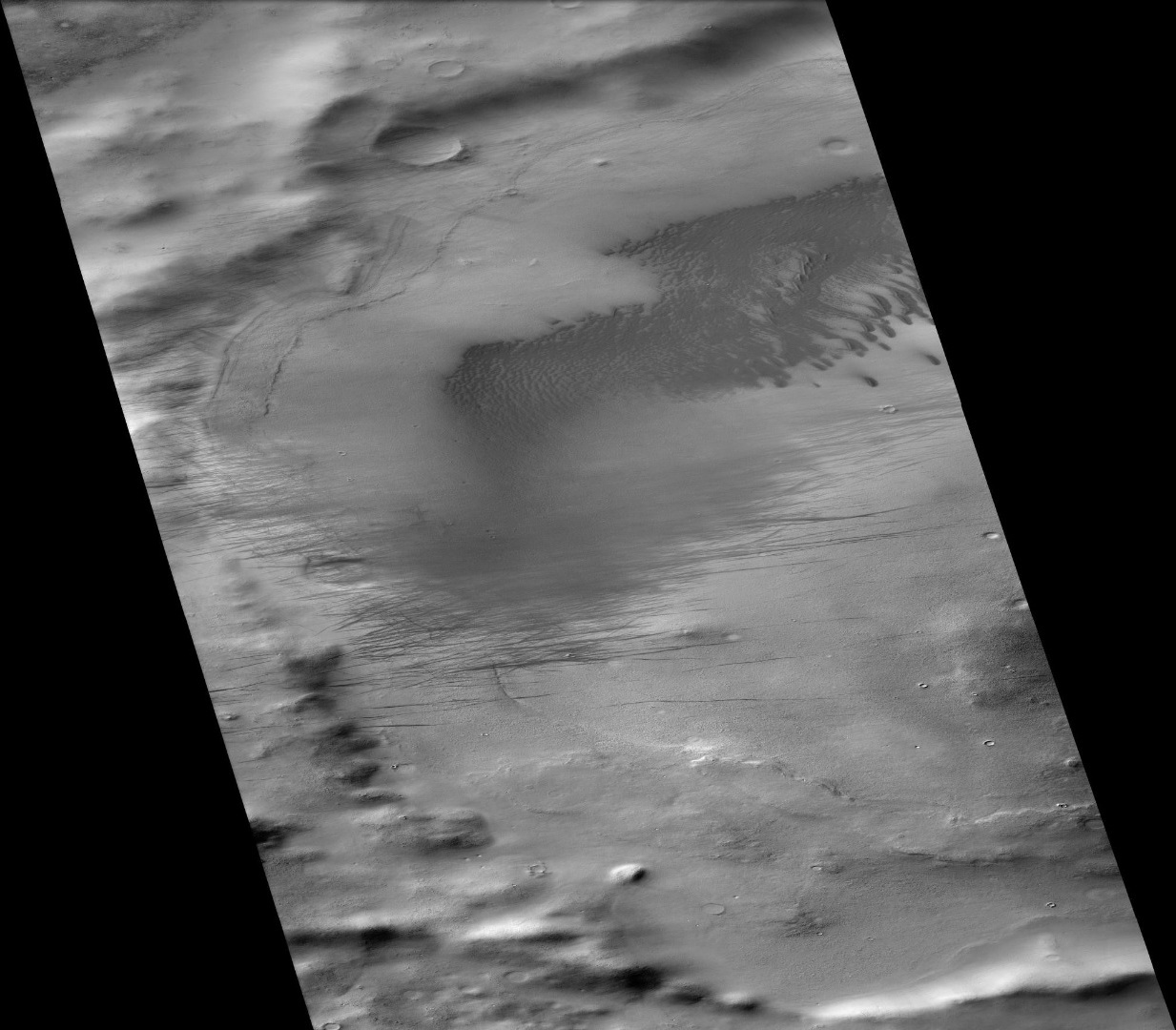 Biachini Crater, as seen by CTX camera (on Mars Reconnaissance Orbiter). Dust devil tracks and dunes are visible on the floor. The narrow, dark lines are dust devil tracks.
Biachini Crater, as seen by CTX camera (on Mars Reconnaissance Orbiter). Dust devil tracks and dunes are visible on the floor. The narrow, dark lines are dust devil tracks.
Glaciers
Since the 70’s, as our spacecraft have studied Mars with more and more advanced cameras and other instruments, we have found more and more evidence for glaciers. [42] [43] [44] [45] [46] [47] [48] On Mars these glaciers are covered with rock and dust debris a few meters to a few tens of meters thick. Although Mars today seems too dry for any glaciers, this covering material has protected the underlying ice. [49] One would think that under today’s conditions any exposed ice would undergo sublimation and disappear into the thin Martian atmosphere. That is, it would go directly from a solid to a gas. But, the isulating effect of surface material prevents loss of ice.[50] [51] Sometimes, the glaciers are active for a time and then the ice in them leaves. However, they leave behind ridges of debris that was carried within and on top of the ice. Often, the ridges make a curved shape.
Arrows indicate glaciers
Other views from Thaumasia
Brain terrain when ice leaves the ground along cracks. It may still contain some ice. Box shows the size of football field.
Dark slope streaks, as seen by HiRISE underHiWish program Dark slope streaks are when bright dust moves down a slope and exposes the underlying dark surface.
Cracks and pits that form square shapes Arrow points to squares formed by cracks.
See also
- Glaciers on Mars
- HiWish program
- How are features on Mars Named?
- Martian features that are signs of water ice
- Martian gullies
- Periodic climate changes on Mars
- Rivers on Mars
References
- ↑ Davies, M.E.; Batson, R.M.; Wu, S.S.C. "Geodesy and Cartography" in Kieffer, H.H.; Jakosky, B.M.; Snyder, C.W.; Matthews, M.S., Eds. Mars. University of Arizona Press: Tucson, 1992.
- ↑ http://areology.blogspot.com/2010/06/ancient-lava-plain-in-thaumasia-planum.html
- ↑ Blunck, J. 1982. Mars and its Satellites. Exposition Press. Smithtown, N.Y.
- ↑ Edgett |first1= K. |last2= Malin |first2= M. C. |last3= Williams |first3= R. M. E. |last4= Davis |first4= S. D. |date= 2003 |title= Polar-and middle-latitude martian gullies: A view from MGS MOC after 2 Mars years in the mapping orbit |journal= Lunar Planet. Sci. |volume=34 |at=p. 1038, Abstract 1038 | url=http://www.lpi.usra.edu/meetings/lpsc2003/pdf/1038.pdf |
- ↑ Harrington |first=J.D. |last2=Webster |first2=Guy |title=RELEASE 14-191 – NASA Spacecraft Observes Further Evidence of Dry Ice Gullies on Mars |url=http://www.nasa.gov/press/2014/july/nasa-spacecraft-observes-further-evidence-of-dry-ice-gullies-on-mars |date=July 10, 2014 |work=NASA
- ↑ CNRS. "Gullies on Mars sculpted by dry ice rather than liquid water." ScienceDaily. ScienceDaily, 22 December 2015. www.sciencedaily.com/releases/2015/12/151222082255.htm
- ↑ http://www.skyandtelescope.com/astronomy-news/martian-gullies-triggered-by-exploding-dry-ice-122320158
- ↑ Dickson, J. et al. 2007. Martian gullies in the southern mid-latitudes of Mars Evidence for climate-controlled formation of young fluvial features based upon local and global topography. Icarus: 188. 315-323.
- ↑ Hecht, M. 2002. Metastability of liquid water on Mars. Icarus: 156. 373-386.
- ↑ Michael H. Carr|title=The surface of Mars|url=https://books.google.com/books?id=uLHlJ6sjohwC%7Caccessdate=21 March 2011|year=2006|publisher=Cambridge University Press|isbn=978-0-521-87201-0
- ↑ Ansan, V and N. Mangold. 2006. New observations of Warrego Valles, Mars: Evidence for precipitation and surface runoff. Icarus. 54:219-242.
- ↑ http://www.msss.com/mars_images/moc/2004/10/03/
- ↑ http://www.lpi.usra.edu/publications/slidesets/stones/
- ↑ http://www.indiana.edu/~sierra/papers/2003/Patterson.html.
- ↑ Osinski, G, J. Spray, and P. Lee. 2001. Impact-induced hydrothermal activity within the Haughton impact structure, arctic Canada: Generation of a transient, warm, wet oasis. Meteoritics & Planetary Science: 36. 731-745
- ↑ http://www.ingentaconnect.com/content/arizona/maps/2005/00000040/00000012/art00007
- ↑ Pirajno, F. 2000. Ore Deposits and Mantle Plumes. Kluwer Academic Publishers. Dordrecht, The Netherlands
- ↑ Head, J. and J. Mustard. 2006. Breccia Dikes and Crater-Related Faults in Impact Craters on Mars: Erosion and Exposure on the Floor of a 75-km Diameter Crater at the Dichotomy Boundary. Special Issue on Role of Volatiles and Atmospheres on Martian Impact Craters Meteoritics & Planetary Science
- ↑ name="news.discovery.com"
- ↑ Segura, T, O. Toon, A. Colaprete, K. Zahnle. 2001. Effects of Large Impacts on Mars: Implications for River Formation. American Astronomical Society, DPS meeting#33, #19.08
- ↑ Segura, T, O. Toon, A. Colaprete, K. Zahnle. 2002. Environmental Effects of Large Impacts on Mars. Science: 298, 1977-1980.
- ↑ Cabrol, N. and E. Grin. 2001. The Evolution of Lacustrine Environments on Mars: Is Mars Only Hydrologically Dormant? Icarus: 149, 291-328.
- ↑ Fassett, C. and J. Head. 2008. Open-basin lakes on Mars: Distribution and implications for Noachian surface and subsurface hydrology. Icarus: 198, 37-56.
- ↑ Fassett, C. and J. Head. 2008. Open-basin lakes on Mars: Implications of valley network lakes for the nature of Noachian hydrology.
- ↑ Wilson, J. A. Grant and A. Howard. 2013. INVENTORY OF EQUATORIAL ALLUVIAL FANS AND DELTAS ON MARS. 44th Lunar and Planetary Science Conference.
- ↑ Newsom H., Hagerty J., Thorsos I. 2001. Location and sampling of aqueous and hydrothermal deposits in martian impact craters. Astrobiology: 1, 71-88.
- ↑ Baker, V., et al. 2015. Fluvial geomorphology on Earth-like planetary surfaces: a review. Geomorphology. 245, 149–182.
- ↑ Carr, M. 1996. in Water on Mars. Oxford Univ. Press.
- ↑ Baker, V. 1982. The Channels of Mars. Univ. of Tex. Press, Austin, TX
- ↑ Baker, V., R. Strom, R., V. Gulick, J. Kargel, G. Komatsu, V. Kale. 1991. Ancient oceans, ice sheets and the hydrological cycle on Mars. Nature 352, 589–594.
- ↑ Carr, M. 1979. Formation of Martian flood features by release of water from confined aquifers. J. Geophys. Res. 84, 2995–300.
- ↑ Komar, P. 1979. Comparisons of the hydraulics of water flows in Martian outflow channels with flows of similar scale on Earth. Icarus 37, 156–181.
- ↑ http://spaceref.com/mars/how-much-water-was-needed-to-carve-valleys-on-mars.html
- ↑ Luo, W., et al. 2017. New Martian valley network volume estimate consistent with ancient ocean and warm and wet climate. Nature Communications 8. Article number: 15766 (2017). doi:10.1038/ncomms15766
- ↑ Hecht | first1 = M | year = 2002 | title = Metastability of water on Mars | url = | journal = Icarus | volume = 156 | issue = 2| pages = 373–386 | doi=10.1006/icar.2001.6794 |
- ↑ Mustard | first1 = J. |display-authors=etal | year = 2001 | title = Evidence for recent climate change on Mars from the identification of youthful near-surface ground ice | url = | journal = Nature | volume = 412 | issue = 6845| pages = 411–414 |
- ↑ Pollack | first1 = J. | last2 = Colburn | first2 = D. | last3 = Flaser | first3 = F. | last4 = Kahn | first4 = R. | last5 = Carson | first5 = C. | last6 = Pidek | first6 = D. | year = 1979 | title = Properties and effects of dust suspended in the martian atmosphere | url = | journal = J. Geophys. Res. | volume = 84 | issue = | pages = 2929–2945 | doi=10.1029/jb084ib06p02929 |
- ↑ https://en.wikipedia.org/wiki/Micrometre
- ↑ http://marsrovers.jpl.nasa.gov/gallery/press/spirit/20070412a.html Mars Exploration Rover Mission: Press Release Images: Spirit. Marsrovers.jpl.nasa.gov. Retrieved on 7 August 2011.
- ↑ http://hirise.lpl.arizona.edu/PSP_005383_1255
- ↑ Reiss, D. et al. 2011. Multitemporal observations of identical active dust devils on Mars with High Resolution Stereo Camera (HRSC) and Mars Orbiter Camera (MOC). Icarus. 215:358-369.
- ↑ Squyres | first1 = S.W. | last2 = Carr | first2 = M.H. | year = 1986 | title = Geomorphic evidence for the distribution of ground ice on Mars | url = | journal = Science | volume = 213 | issue = | pages = 249–253 | doi = 10.1126/science.231.4735.249 |
- ↑ Head | first1 = J.W. | last2 = Marchant | first2 = D.R. | last3 = Dickson | first3 = J.L. | last4 = Kress | first4 = A.M. | year = 2010 | title = Criteria for the recognition of debris-covered glacier and valley glacier landsystem deposits | url = | journal = Earth Planet. Sci. Lett. | volume = 294 | issue = | pages = 306–320 | doi=10.1016/j.epsl.2009.06.041 |
- ↑ Holt | first1 = J.W. | display-authors = 1 | last2 = et al | year = 2008 | title = Radar sounding evidence for buried glaciers in the southern mid-latitudes of Mars | url = | journal = Science | volume = 322 | issue = | pages = 1235–1238 | doi=10.1126/science.1164246 | pmid=19023078|
- ↑ Morgan | first1 = G.A. | last2 = Head | first2 = J.W. | last3 = Marchant | first3 = D.R. | year = 2009 | title = Lineated valley fill (LVF) and lobate debris aprons (LDA) in the Deuteronilus Mensae northern dichotomy boundary region, Mars: Constraints on the extent, age and episodicity of Amazonian glacial events | url = | journal = Icarus | volume = 202 | issue = | pages = 22–38 | doi=10.1016/j.icarus.2009.02.017 |
- ↑ Plaut | first1 = J.J. | last2 = Safaeinili | first2 = A. | last3 = Holt | first3 = J.W. | last4 = Phillips | first4 = R.J. | last5 = Head | first5 = J.W. | last6 = Sue | first6 = R. | last7 = Putzig | first7 = A. | year = 2009 | title = Frigeri Radar evidence for ice in lobate debris aprons in the mid-northern latitudes of Mars | doi = 10.1029/2008gl036379 | journal = Geophys. Res. Lett. | volume = 36 | issue = | page = L02203 |
- ↑ Baker | first1 = D.M.H. | last2 = Head | first2 = J.W. | last3 = Marchant | first3 = D.R. | year = 2010 | title = Flow patterns of lobate debris aprons and lineated valley fill north of Ismeniae Fossae, Mars: Evidence for extensive mid-latitude glaciation in the Late Amazonian | url = | journal = Icarus | volume = 207 | issue = | pages = 186–209 | doi=10.1016/j.icarus.2009.11.017 |
- ↑ Arfstrom | first1 = J. | year = 2005 | title = Terrestrial analogs and interrelationships | url = | journal = Icarus | volume = 174 | issue = | pages = 321–335 | doi=10.1016/j.icarus.2004.05.026 |
- ↑ Williams | first1 = K. E. | display-authors = 1 | last2 = et al | year = 2008 | title = Stability of mid-latitude snowpacks on Mars | url = | journal = Icarus | volume = 196 | issue = 2| pages = 565–577 | doi=10.1016/j.icarus.2008.03.017 |
- ↑ Head | first1 = J. | date = 2005 | last2 = Neukum | first2 = G. | last3 = Jaumann | first3 = R. | last4 = Hiesinger | first4 = H. | last5 = Hauber | first5 = E. | last6 = Carr | first6 = M. | last7 = Masson | first7 = P. | last8 = Foing | first8 = B. | last9 = Hoffmann | first9 = H. | last10 = Kreslavsky | first10 = M. | last11 = Werner | first11 = S. | last12 = Milkovich | first12 = S. | last13 = Van Gasselt | first13 = S. | last14 = Co-Investigator Team | first14 = The Hrsc | title = Tropical to mid-latitude snow and ice accumulation, flow and glaciation on Mars | url = | journal=Nature | volume = 434 | issue = 7031| pages = 346–350 | pmid=15772652|
- ↑ Head, J., et al. 2009. Northern mid-latitude glaciation in the Late Amazonian period of Mars: Criteria for the recognition of debris-covered glacier and valley glacier landsystem deposits. Earth and Planetary Science Letters. Doi:10.1016/j.epsl.2009.06.041
Further reading
- Lorenz, R. 2014. The Dune Whisperers. The Planetary Report: 34, 1, 8-14
- Lorenz, R., J. Zimbelman. 2014. Dune Worlds: How Windblown Sand Shapes Planetary Landscapes. Springer Praxis Books / Geophysical Sciences.

